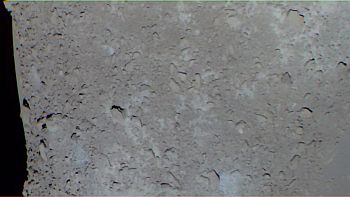
A relatively colorless image
If you boost the saturation of the image you can begin to see significant differences in the rocks on the surface and the underlying regolith.

(movement of the satellite is the source of the color fringes)
Near-infrared Spectral Results of Asteroid Itokawa..." talks about the rich pyroxene and olivine (olivine being a very simple Fe and Mg silicate) results--suggesting the origin of the asteroid was from the inner asteroid belt, with any variations in spectra due to clast size. (see this graph for an example) (both links may require a subscription).
P.S. See additional Itokawa talk here. And see my synthesis of a color image of Earth from Hayabusa.
P.P.S. Look at that crazy huge boulder sitting on the surface: here and here!
No comments:
Post a Comment